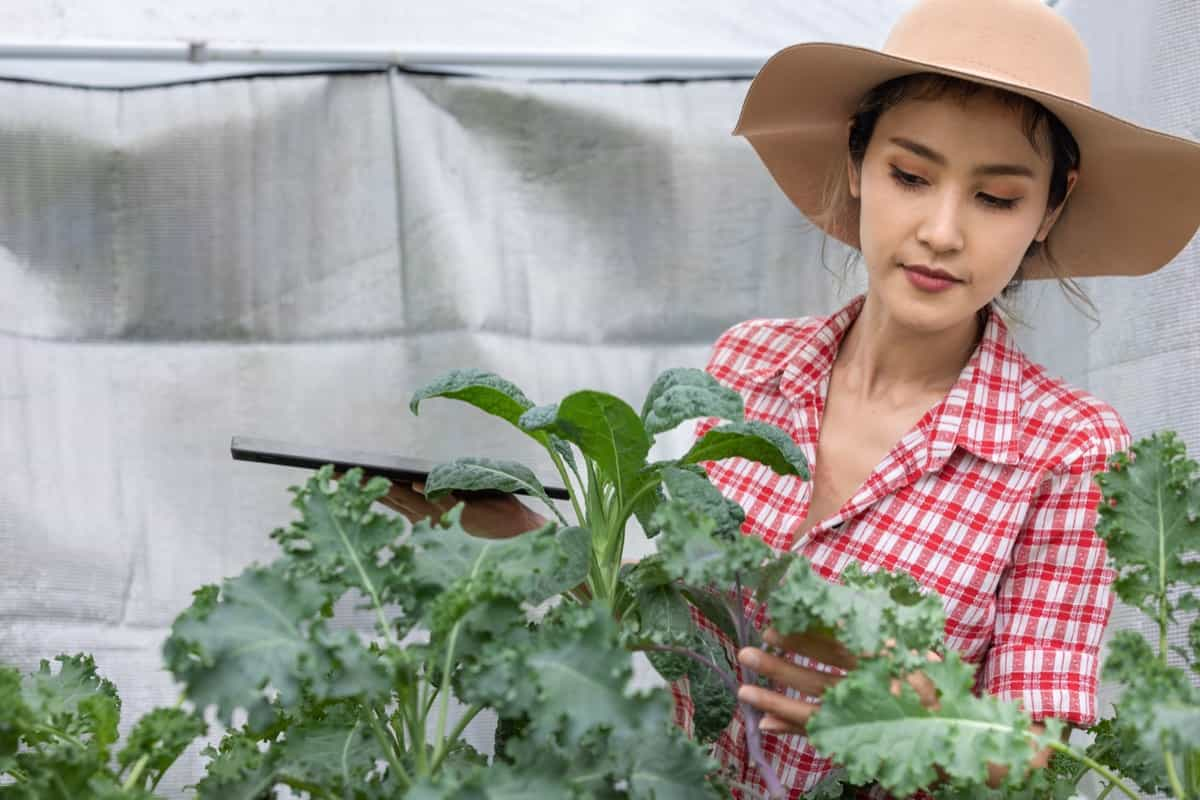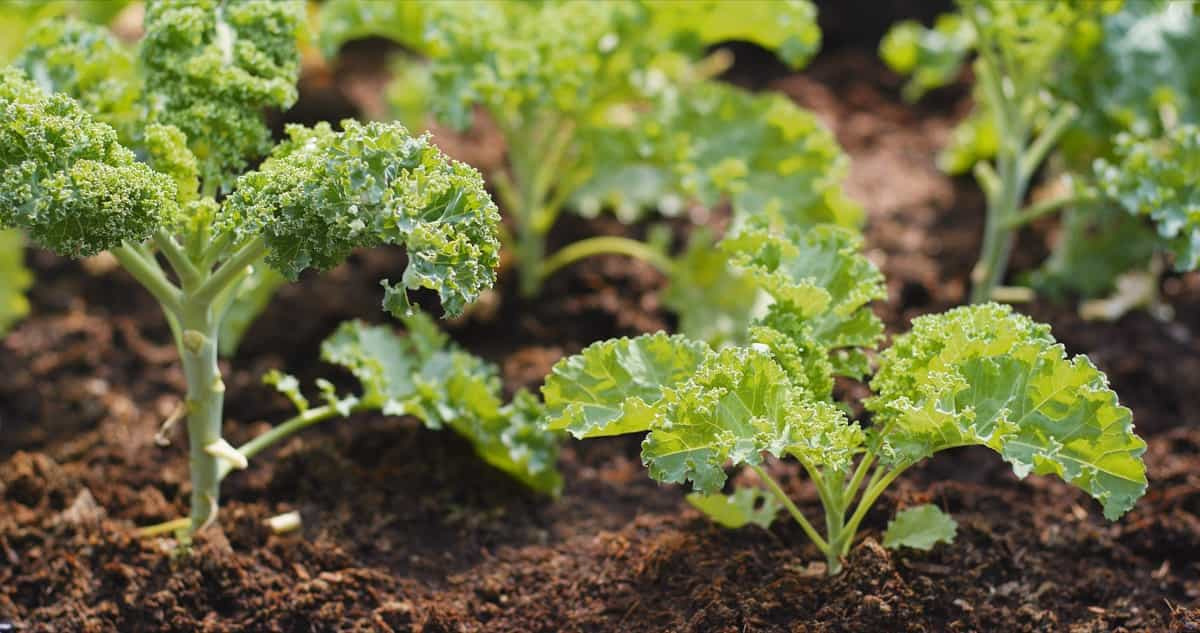Kale plants, scientifically known as Brassica oleracea, are highly nutritious and versatile leafy greens popular among gardeners and health-conscious individuals. However, like any other plant, Kale can encounter various problems hindering its growth and overall health. This article will discuss nine common problems kale plants face and provide effective treatments and solutions for each issue.

9 Common Problems With Kale Plants
Preventing Kale Aphid Infestations: Natural Control Methods
Aphids are common pests that feed on the sap of plants, including Kale. These tiny insects are typically green or black and can reproduce rapidly, leading to infestations.
Natural Kale Aphids Control
- Planting aphid-repellent companion plants like marigolds, mint, or garlic around Kale can deter aphids from infesting the plants.
- Spraying neem oil, a natural insecticide derived from the neem tree, can help control aphids on Kale. Follow the manufacturer’s instructions for application.
- Use insecticidal soap specifically formulated to prevent aphids on Kale. Apply it as directed on the label, ensuring complete coverage of affected kale plants.
Cabbage Aphids on Kale
Cabbage aphids are a common pest that can infest kale plants. These small insects feed on the sap, causing damage to the leaves and stunting growth. Soapy water is one of Kale’s most popular natural treatments for cabbage aphids. To use this treatment, spray the soapy water directly onto the affected areas of the kale plant, covering both the leaves’ upper and lower surfaces.
Dealing With Yellowing Leaves on Kale Plants: Causes and Solutions
Growing Kale leaves turning yellow can cause concern for many gardeners. Yellowing leaves on kale plants can indicate various issues, but the problem can often be resolved with proper diagnosis and treatment.
- One common cause of yellowing leaves on kale plants is nutrient deficiencies. Kale plants require a balanced supply of nutrients to thrive, and a lack of essential nutrients can lead to yellowing leaves.
- Pests can also be a culprit behind yellowing leaves on kale plants. Aphids, for example, can suck the sap from the leaves, which leads to turn yellow and wilt. To combat pests, you can try using organic insecticidal soap.
- Diseases can also contribute to yellowing leaves on kale plants. For instance, fungal diseases like downy or powdery mildew can cause yellow spots or a white powdery coating on the leaves. To prevent the spread of diseases, ensure adequate air circulation around your plants by spacing them properly.
Controlling Fungal Diseases in Kale Plants
- Kale Stem Rot: Kale stem rot is caused by the fungal pathogen Rhizoctonia solani. This disease primarily affects the stems of kale plants, resulting in wilting, discoloration, and rotting of the affected tissues.
- Treatment: Farmers often use fungicides containing active ingredients such as azoxystrobin, pyraclostrobin, or boscalid to control kale stem rot.
- Downy Mildew Kale: Downy mildew, caused by the fungus Peronospora brassicae, is another common fungal disease that affects kale plants. Symptoms of downy mildew include yellowing of leaves, the appearance of a whitish downy growth on the undersides of leaves, and leaf curling.
- Treatment: To combat downy mildew, farmers and gardeners rely on fungicides containing active ingredients such as copper compounds, mancozeb, or cymoxanil.
In case you missed it: Unraveling the 7 Causes of Dying Kale and How to Fix It?

Identifying and Treating Kale Leaf Spot Diseases
Kale leaf spot diseases can significantly impact the health and yield of kale plants. Various fungal pathogens cause these diseases and can result in the development of unsightly brown spots on the Kale leaves.
Black Spot: This disease is characterized by forming small black spots on the kale leaves. Over time, the spots may enlarge and develop a concentric ring pattern. Fungicides containing chlorothalonil or mancozeb are effective against this disease.
Gray Mold: Gray mold appears as fuzzy gray patches on the kale leaves, which may later turn brown. The affected leaves may also become water-soaked and display a slimy texture. Fungicides like boscalid or pyrimethanil can help control this.
Downy Mildew: Downy mildew causes yellowish or pale green spots on the upper surface of kale leaves. Fungicides containing copper compounds or cymoxanil to manage it.
Managing Nutrient Deficiencies in Kale Plants
| Nutrient deficiency | Symptoms | management |
| Nitrogen | Yellowing of lower leaves, stunted growth | Compost, fish emulsion, blood meal |
| Phosphorus | Purple leaves, poor root development | Bone meal, rock phosphate |
| Potassium | Yellowing and curling of leaf margins, weak stems | Kelp meal, wood ash |
| Calcium | Stunted growth, distorted leaves, blossom end rot | Dolomite lime, gypsum |
Preventing Kale Plants From Bolting Prematurely
Kale Bolting refers to where a plant prematurely goes to seed. In the case of Kale bolting, Kale appears tall and leggy. It develops a central stalk that elongates and produces flowers. The leaves become smaller and less tender compared to non-bolting Kale. Overall, bolting Kale looks less vibrant and vigorous. To prevent Kale Plants from Bolting Prematurely
- High temperatures are one of the primary causes of kale bolting. Plant kale in cooler climates or provide shade during hot summer to avoid the stress that triggers bolting.
- Fertilize kale plants with a balanced organic fertilizer to promote healthy growth. Avoid excessive nitrogen, as it can stimulate bolting. Instead, focus on providing a balanced nutrient blend that supports leaf development.
- Harvesting Kale leaves regularly encourages new growth and discourages bolting. Remove any flower buds or stalks that emerge to redirect the plant’s energy back into leaf production.
Identifying and Treating Kale Caterpillar Damage
The kale caterpillar is a common culprit that can cause significant damage to kale leaves. If you have noticed holes in your kale leaves, kale caterpillars are likely responsible for the damage.
Identifying Kale Caterpillar Damage
- Holes in Kale Leaves: The primary sign of kale caterpillar damage is the presence of small, irregularly shaped holes in the leaves.
- Chewed Edges: Kale caterpillars feed on the leaf edges, producing a distinctive pattern of chewed or ragged edges.
- Frass or Droppings: Another indicator of kale caterpillar presence is the presence of small black or green droppings, known as frass, on the leaves.
Treatment for Kale Caterpillar Damage: Bacillus thuringiensis (Bt) is a commonly recommended organic insecticide that is safe to use on edible plants like Kale.
Managing Excessive Growth and Overcrowding in Kale Plants
Managing excessive growth and overcrowding in kale plants can be achieved by ensuring proper spacing between plants during planting and regular thinning of seedlings to create adequate room for growth. Additionally, pruning and trimming can help control excessive growth while providing sufficient sunlight and nutrients can prevent overcrowding. Monitoring the plants for signs of overcrowding and promptly addressing the issue can also effectively manage excessive growth.
In case you missed it: Unraveling the 7 Causes of Dying Kale and How to Fix It?

Dealing With Kale Plants Not Forming Tender Leaves
- Kale requires well-drained soil that is rich in organic matter. If the soil is too compacted or lacks nutrients, it can hinder the growth of the plants and result in tough leaves. To rectify this issue, amend the soil with compost or aged manure before planting.
- Insufficient sunlight can lead to slow growth and tough leaves. Ensure your kale plants get 6-8 hours of direct sunlight daily, at least.
- Pests and diseases can also impact the tenderness of kale leaves. Implementing organic pest control methods, such as handpicking or using insecticidal soaps, can help manage these issues effectively.
Conclusion
By addressing these common problems and implementing the appropriate treatments and solutions, you can ensure your kale plants’ optimal growth and health. Remember to monitor your plants regularly, maintain proper care practices, and make timely interventions when necessary. Happy gardening!
- Feed Your Flock for Less: Top 10 Tips to Save on Chicken Feed
- Ultimate Guide to Ossabaw Island Hog: Breeding, Raising, Diet, and Care
- Hatching Answers: The Top 10 Reasons Your Chickens Aren’t Laying Eggs
- Eggs and Economics: Breaking Down the Cost of Raising Backyard Chickens
- Defend Your Greens: Proven Methods to Keep Iguanas Out of Your Garden
- Ultimate Guide to Cinnamon Queen Chicken: A Comprehensive Guide for Beginners
- Ultimate Guide to California Tan Chicken: Breeding, Raising, Diet, Egg-Production and Care
- Ultimate Guide to Marsh Daisy Chicken: Breeding, Raising, Diet, and Care
- 10 Types of Chicken Farming Businesses You Can Start for Profits